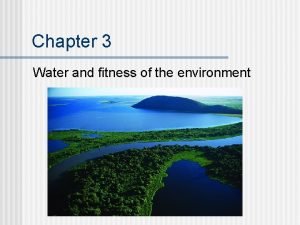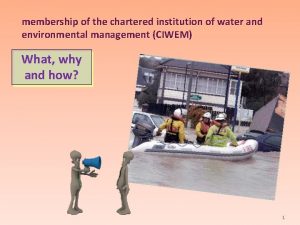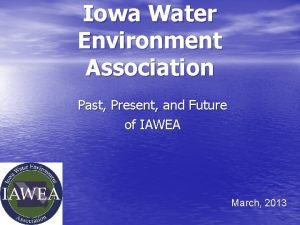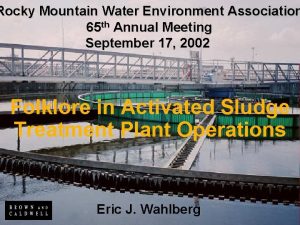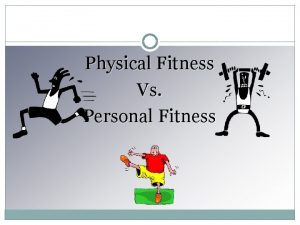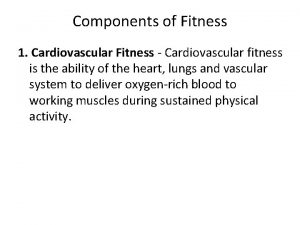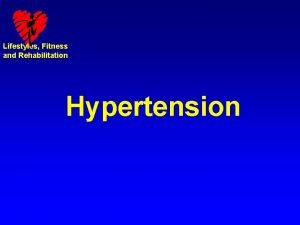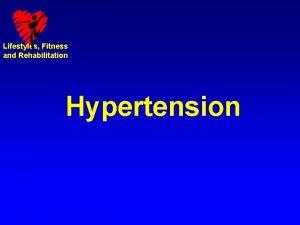Water and the Fitness of the Environment Water






































- Slides: 38

Water and the Fitness of the Environment

Water: The Molecule That Supports All of Life • All living organisms require water more than any other substance • Most cells are surrounded by water, and cells themselves are about 70– 95% water • The abundance of water is the main reason the Earth is habitable Copyright © 2008 Pearson Education, Inc. , publishing as Pearson Benjamin Cummings

Fig. 3 -1

Concept 3. 1: The polarity of water molecules results in hydrogen bonding • The water molecule is a polar molecule: The opposite ends have opposite charges • Polarity allows water molecules to form hydrogen bonds with each other Animation: Water Structure Copyright © 2008 Pearson Education, Inc. , publishing as Pearson Benjamin Cummings


Concept 3. 2: Four emergent properties of water contribute to Earth’s fitness for life • Four of water’s properties that facilitate an environment for life are: – Cohesive behavior – Ability to moderate temperature – Expansion upon freezing – Versatility as a solvent Copyright © 2008 Pearson Education, Inc. , publishing as Pearson Benjamin Cummings

Cohesion • Collectively, hydrogen bonds hold water molecules together, a phenomenon called cohesion • Cohesion helps the transport of water against gravity in plants • Adhesion is an attraction between different substances, for example, between water and plant cell walls Animation: Water Transport Copyright © 2008 Pearson Education, Inc. , publishing as Pearson Benjamin Cummings

Fig. 3 -3 Adhesion Water-conducting cells Direction of water movement Cohesion 150 µm

• Surface tension is a measure of how hard it is to break the surface of a liquid • Surface tension is related to cohesion Copyright © 2008 Pearson Education, Inc. , publishing as Pearson Benjamin Cummings

Fig. 3 -4



Moderation of Temperature • Water absorbs heat from warmer air and releases stored heat to cooler air • Water can absorb or release a large amount of heat with only a slight change in its own temperature Copyright © 2008 Pearson Education, Inc. , publishing as Pearson Benjamin Cummings

Water’s High Specific Heat • The specific heat of a substance is the amount of heat that must be absorbed or lost for 1 g of that substance to change its temperature by 1ºC • Water resists changing its temperature because of its high specific heat Copyright © 2008 Pearson Education, Inc. , publishing as Pearson Benjamin Cummings

• Water’s high specific heat? It’s all hydrogen bonding! – Heat is absorbed when hydrogen bonds break – Heat is released when hydrogen bonds form • More moderate temperature changes allow for more Life! Copyright © 2008 Pearson Education, Inc. , publishing as Pearson Benjamin Cummings


Fig. 3 -5 Los Angeles (Airport) 75° 70 s (°F) 80 s 90 s 100 s San Bernardino 100° Riverside 96° Santa Ana Palm Springs 84° 106° Burbank 90° Santa Barbara 73° Pacific Ocean San Diego 72° 40 miles

Evaporative Cooling • Evaporation is transformation of a substance from liquid to gas • As a liquid evaporates, its remaining surface cools, a process called evaporative cooling • Evaporative cooling of water helps stabilize temperatures in organisms and bodies of water Copyright © 2008 Pearson Education, Inc. , publishing as Pearson Benjamin Cummings

Insulation of Bodies of Water by Floating Ice • Ice floats in liquid water because hydrogen bonds in ice are more “ordered, ” making ice less dense • Water reaches its greatest density at 4°C • If ice sank, all bodies of water would eventually freeze solid, making life impossible on Earth Copyright © 2008 Pearson Education, Inc. , publishing as Pearson Benjamin Cummings

Fig. 3 -6 Hydrogen bond Ice Hydrogen bonds are stable Liquid water Hydrogen bonds break and re-form

Fig. 3 -6 a Hydrogen bond Ice Hydrogen bonds are stable Liquid water Hydrogen bonds break and re-form

The Solvent of Life • A solution is a liquid that is a homogeneous mixture of substances • A solvent is the dissolving agent of a solution • The solute is the substance that is dissolved • An aqueous solution is one in which water is the solvent Copyright © 2008 Pearson Education, Inc. , publishing as Pearson Benjamin Cummings

• Water is a versatile solvent (Universal solvent!) due to its polarity, which allows it to form hydrogen bonds easily • When an ionic compound is dissolved in water, each ion is surrounded by a sphere of water molecules called a hydration shell Copyright © 2008 Pearson Education, Inc. , publishing as Pearson Benjamin Cummings


• Even large non-polar molecules such as proteins can dissolve in water if they have ionic and polar regions Copyright © 2008 Pearson Education, Inc. , publishing as Pearson Benjamin Cummings

Fig. 3 -8 ab (a) Lysozyme molecule in a nonaqueous environment (b) Lysozyme molecule (purple) in an aqueous environment

Fig. 3 -8 bc (b) Lysozyme molecule (purple) in an aqueous environment (c) Ionic and polar regions on the protein’s surface attract water molecules.

Hydrophilic and Hydrophobic Substances • A hydrophilic substance is one that has an affinity for water (is attracted to) • A hydrophobic substance is one that does not have an affinity for water • Oil molecules are hydrophobic because they have relatively nonpolar bonds Copyright © 2008 Pearson Education, Inc. , publishing as Pearson Benjamin Cummings

Fig. 3 -UN 2 p. H H O H 2 H 2 O H H Hydronium ion (H 3 O+) O H Hydroxide ion (OH–)

• Though statistically rare, the dissociation of water molecules has a great effect on organisms • Changes in concentrations of H+ and OH– can drastically affect the chemistry of a cell! (Remember those little pushes and pulls from hydrogen bonds and Van der Waals forces. . ? ) Copyright © 2008 Pearson Education, Inc. , publishing as Pearson Benjamin Cummings

Effects of Changes in p. H • Concentrations of H+ and OH– are equal in pure water • Adding certain solutes, called acids and bases, modifies the concentrations of H+ and OH– • Biologists use something called the p. H scale to describe whether a solution is acidic or basic (the opposite of acidic) Copyright © 2008 Pearson Education, Inc. , publishing as Pearson Benjamin Cummings

Acids and Bases • An acid is any substance that increases the H+ concentration of a solution • A base is any substance that reduces the H+ concentration of a solution Copyright © 2008 Pearson Education, Inc. , publishing as Pearson Benjamin Cummings

• Acidic solutions have p. H values less than 7 • Basic solutions have p. H values greater than 7 • Most biological fluids have p. H values in the range of 6 to 8 Copyright © 2008 Pearson Education, Inc. , publishing as Pearson Benjamin Cummings

Fig. 3 -9 p. H Scale 0 H+ H+ + – H H+ OH– H H+ H+ H+ Acidic solution Increasingly Acidic [H+] > [OH–] 1 Battery acid Gastric juice, 2 lemon juice 3 Vinegar, beer, wine, cola 4 Tomato juice 5 Black coffee Rainwater 6 Urine OH– H+ OH– OH– + H+ H+ H Neutral [H+] = [OH–] 8 Seawater OH– H+ OH– – OH OH– + H Basic solution Increasingly Basic [H+] < [OH–] Neutral solution OH– Saliva 7 Pure water Human blood, tears 9 10 Milk of magnesia 11 Household ammonia 12 Household 13 bleach Oven cleaner 14

Buffers • The internal p. H of most living cells must remain close to p. H 7 • Buffers are substances that minimize changes in concentrations of H+ and OH– in a solution • (Most buffers consist of an acid-base pair that reversibly combines with H+ - it reduces too much H+ or increases too little H+) Copyright © 2008 Pearson Education, Inc. , publishing as Pearson Benjamin Cummings

Threats to Water Quality on Earth • Acid precipitation refers to rain, snow, or fog with a p. H lower than 5. 6 • Acid precipitation is caused mainly by the mixing of different pollutants with water in the air and can fall at some distance from the source of pollutants • Acid precipitation can damage life in lakes and streams • Effects of acid precipitation on soil chemistry are contributing to the decline of some forests Copyright © 2008 Pearson Education, Inc. , publishing as Pearson Benjamin Cummings

Fig. 3 -10 0 1 2 3 4 5 6 7 8 9 10 11 12 13 14 More acidic Acid rain Normal rain More basic

• Human activities such as burning fossil fuels threaten water quality • CO 2 is released by fossil fuel combustion and contributes to: – A warming of earth called the “greenhouse” effect – Acidification of the oceans; this leads to a decrease in the ability of corals to form calcified reefs. More CO 2 also increases growth of algae in the ocean. Copyright © 2008 Pearson Education, Inc. , publishing as Pearson Benjamin Cummings
 Chapter 3 water and the fitness of the environment
Chapter 3 water and the fitness of the environment Water and water and water water
Water and water and water water Skill related fitness vs health related fitness
Skill related fitness vs health related fitness Environment of business finance
Environment of business finance Chartered institute of water environment management
Chartered institute of water environment management Iowa water environment association
Iowa water environment association Rocky mountain water environment association
Rocky mountain water environment association Health and fitness: theory and practice
Health and fitness: theory and practice Hát kết hợp bộ gõ cơ thể
Hát kết hợp bộ gõ cơ thể Bổ thể
Bổ thể Tỉ lệ cơ thể trẻ em
Tỉ lệ cơ thể trẻ em Voi kéo gỗ như thế nào
Voi kéo gỗ như thế nào Tư thế worms-breton
Tư thế worms-breton Hát lên người ơi
Hát lên người ơi Kể tên các môn thể thao
Kể tên các môn thể thao Thế nào là hệ số cao nhất
Thế nào là hệ số cao nhất Các châu lục và đại dương trên thế giới
Các châu lục và đại dương trên thế giới Công thức tính thế năng
Công thức tính thế năng Trời xanh đây là của chúng ta thể thơ
Trời xanh đây là của chúng ta thể thơ Mật thư anh em như thể tay chân
Mật thư anh em như thể tay chân Làm thế nào để 102-1=99
Làm thế nào để 102-1=99 độ dài liên kết
độ dài liên kết Các châu lục và đại dương trên thế giới
Các châu lục và đại dương trên thế giới Thơ thất ngôn tứ tuyệt đường luật
Thơ thất ngôn tứ tuyệt đường luật Quá trình desamine hóa có thể tạo ra
Quá trình desamine hóa có thể tạo ra Một số thể thơ truyền thống
Một số thể thơ truyền thống Cái miệng nó xinh thế chỉ nói điều hay thôi
Cái miệng nó xinh thế chỉ nói điều hay thôi Vẽ hình chiếu vuông góc của vật thể sau
Vẽ hình chiếu vuông góc của vật thể sau Nguyên nhân của sự mỏi cơ sinh 8
Nguyên nhân của sự mỏi cơ sinh 8 đặc điểm cơ thể của người tối cổ
đặc điểm cơ thể của người tối cổ V cc cc
V cc cc Vẽ hình chiếu đứng bằng cạnh của vật thể
Vẽ hình chiếu đứng bằng cạnh của vật thể Vẽ hình chiếu vuông góc của vật thể sau
Vẽ hình chiếu vuông góc của vật thể sau Thẻ vin
Thẻ vin đại từ thay thế
đại từ thay thế điện thế nghỉ
điện thế nghỉ Tư thế ngồi viết
Tư thế ngồi viết Diễn thế sinh thái là
Diễn thế sinh thái là
